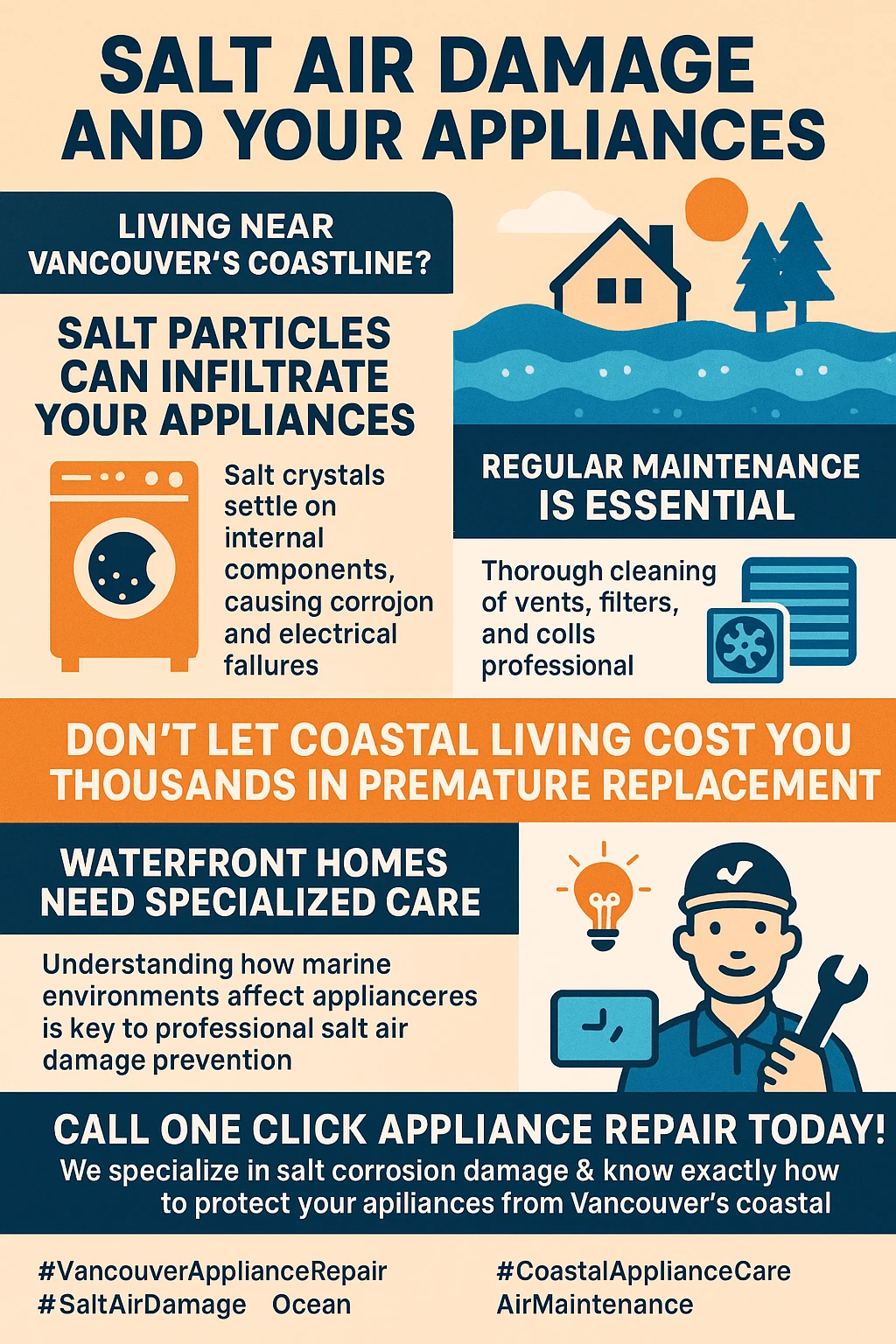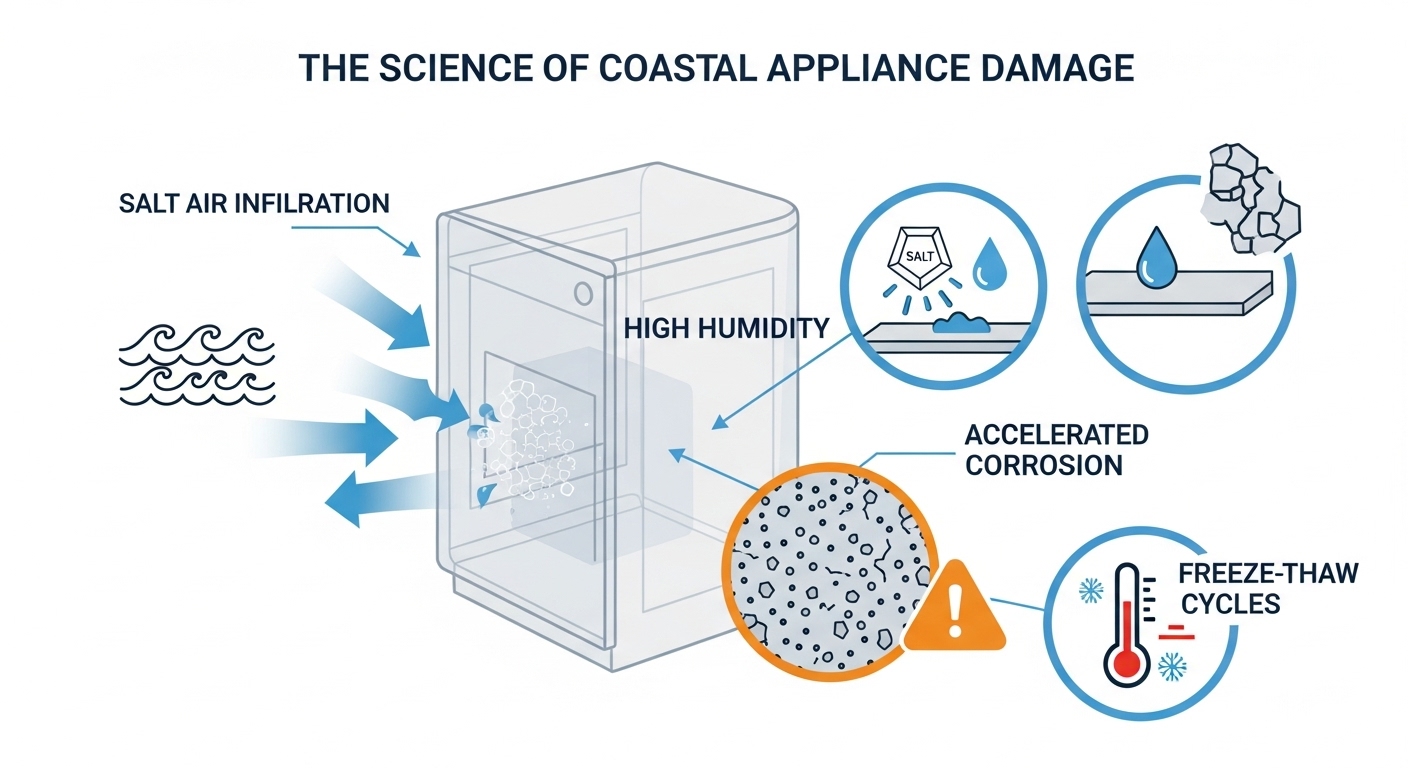Wondering why your expensive appliances keep mysteriously breaking down despite living in beautiful Vancouver? The salt-laden ocean spray that makes our sunsets so spectacular is simultaneously infiltrating your home and systematically corroding your most essential household equipment from the inside out, potentially costing you thousands in premature replacements. 
Picture this all-too-common scenario: you’re enjoying your morning coffee with that gorgeous North Shore mountain view when your three-year-old dishwasher suddenly starts making grinding noises and leaves white film on all your dishes. Later that week, your washing machine begins vibrating violently during spin cycles, and by month’s end, your refrigerator’s ice maker gives up entirely. What you’re experiencing isn’t just bad luck or poor manufacturing – it’s the direct result of Vancouver’s coastal environment waging a silent war against every appliance in your home.
The harsh reality that most Vancouver homeowners discover too late is that our stunning marine climate creates a perfect storm of conditions that can reduce appliance lifespans by up to 40% compared to inland locations. Salt particles from ocean spray travel much further than you’d expect, penetrating deep into Burnaby, Richmond, and even Surrey neighborhoods where they settle into the internal mechanisms of your appliances. Combined with our notorious humidity levels and constant freeze-thaw cycles, these environmental factors create corrosion patterns that manufacturers never anticipated when designing their products for mass market distribution.
The financial implications are staggering when you consider that the average Vancouver home contains $15,000 to $20,000 worth of appliances, many of which contain sophisticated electronic components that are incredibly vulnerable to salt air contamination. What makes this situation particularly frustrating is how preventable most of these failures actually are. Understanding the science behind coastal appliance damage and implementing targeted protection strategies can extend your appliances’ lives by 3-5 years while saving thousands in replacement costs. The key is recognizing which appliances are most vulnerable, when they’re at greatest risk, and what specific steps you can take to protect your investment from Vancouver’s beautiful but destructive marine environment.
Key Outtakes:
- Vancouver’s coastal climate reduces appliance lifespans by 20-40% compared to inland locations due to salt air corrosion and humidity damage
- Salt particles can penetrate up to 25 kilometers inland, affecting appliances in Burnaby, Richmond, and Surrey, not just waterfront properties
- Proper maintenance strategies can extend appliance life by 3-5 years, potentially saving homeowners $3,000-$8,000 in premature replacement costs
- Seven specific appliances are most vulnerable to coastal damage, with washing machines and dryers leading failure rates during Vancouver’s rainy season
- Professional moisture protection systems prevent 80% of salt air damage incidents when properly maintained

The Science Behind Salt Air Appliance Damage in Vancouver
Understanding how Vancouver’s coastal environment systematically attacks your appliances requires looking beyond the obvious surface corrosion that most homeowners notice. The scientific process begins with microscopic salt particles carried by ocean winds that can travel surprising distances inland, reaching homes in Burnaby, Richmond, and Surrey with enough concentration to cause measurable appliance damage. These chloride ions are particularly destructive because they interfere with metals’ ability to form protective oxide layers, leading to a specific type of deterioration called pitting corrosion that eats through components from the inside out.
What makes Vancouver’s situation uniquely challenging is how our marine climate creates a triple threat of environmental stressors that work together to accelerate appliance deterioration. The combination of salt-laden air, persistently high humidity levels exceeding 60% during our rainy season, and frequent freeze-thaw temperature cycles creates conditions that are far more destructive than any single environmental factor alone. This synergistic effect explains why appliances in Vancouver often fail in ways that seem mysterious or premature compared to similar units operating in drier climates.

The molecular process of salt air corrosion begins the moment ocean spray makes contact with your appliances’ metal components. Salt particles don’t just sit on surfaces – they actively attract moisture from the air, creating electrolytic conditions that promote galvanic corrosion between different metals within the same appliance. This process continues 24/7, gradually weakening electrical connections, corroding cooling coils, and compromising the structural integrity of internal components that were never designed to withstand continuous salt exposure.
Vancouver’s unique geography amplifies these destructive processes in ways that other coastal cities don’t experience. Our position between the Pacific Ocean and the Coast Mountains creates wind patterns that can carry salt particles up to 25 kilometers inland during storms, while the surrounding topography traps moisture-laden air that keeps humidity levels consistently elevated. Even during seemingly dry periods, salt residue that has accumulated on appliance surfaces continues to attract atmospheric moisture, maintaining corrosive conditions long after the initial salt exposure occurred.
The temperature fluctuations characteristic of Vancouver’s mild but variable climate create additional stress cycles that compound salt air damage. Unlike extreme cold climates where appliances adapt to sustained low temperatures, Vancouver’s frequent transitions between near-freezing nights and mild days cause repeated expansion and contraction of metal components. These thermal cycling events gradually loosen connections, crack seals, and create micro-pathways that allow salt-contaminated moisture to penetrate deeper into appliance interiors where it can cause catastrophic damage to electronic control systems.
The 7 Most Vulnerable Appliances in Vancouver’s Marine Environment
While all household appliances face challenges in Vancouver’s coastal climate, research and repair data reveal that seven specific types of equipment are particularly vulnerable to salt air damage, each failing in predictable patterns that homeowners can learn to anticipate and prevent. Understanding which appliances are at greatest risk allows you to prioritize your maintenance efforts and budget for potential replacements before emergency situations arise.

Washing machines lead the list of vulnerable appliances because they face a double assault from both internal moisture and external salt air infiltration. Front-loading models are especially susceptible because their horizontal drum design and rubber door seals create perfect conditions for salt residue to accumulate and promote mold growth. The combination of Vancouver’s high humidity and salt air accelerates the deterioration of these rubber components, leading to leaks that can cause thousands of dollars in water damage while voiding manufacturer warranties that specifically exclude environmental contamination.
Dryers represent the second most vulnerable appliance category due to their constant battle against moisture during Vancouver’s extended rainy season. These hardworking machines run 50% more frequently than in drier climates, as families struggle with constantly damp clothing and inadequate natural drying conditions. The increased usage, combined with salt air that penetrates through ventilation systems, leads to accelerated wear on heating elements, moisture sensors, and electronic control boards that can cost more to replace than the appliance is worth.
Refrigerators and freezers suffer significant damage from salt air exposure because their condenser coils act like giant air filters that trap salt particles from the surrounding environment. When these coils become coated with salt-contaminated dust, their ability to dissipate heat drops dramatically, forcing compressors to work overtime and consume up to 30% more energy while dramatically shortening their operational lifespan. This problem affects even homes in Burnaby and Richmond, not just waterfront properties, because salt particles can remain suspended in air for days after initial ocean spray events.
HVAC systems face unique challenges in Vancouver’s marine climate because they actively draw salt-contaminated outdoor air through their intake systems while simultaneously dealing with the high indoor humidity levels that our climate creates. The combination of salt exposure and moisture creates ideal conditions for copper-aluminum galvanic corrosion in condenser units, while indoor air handlers struggle with mold growth and electronic component failures that manifest as mysterious operational problems long before any visible damage becomes apparent.
Dishwashers experience accelerated failure rates in Vancouver due to the combination of hard water deposits and salt air infiltration that affects their electronic control systems. Door seals and internal spray arms are particularly vulnerable because salt particles can accumulate in areas where normal cleaning cycles can’t reach, creating localized corrosion that gradually compromises water circulation and drying performance. The high humidity in Vancouver kitchens also promotes bacterial growth in areas that remain moist between cycles, creating odors and potential health concerns.
The Hidden Economic Impact of Coastal Appliance Corrosion
The true cost of living in Vancouver’s beautiful coastal environment extends far beyond the premium prices we pay for oceanview properties and includes a hidden tax on household appliances that can easily reach thousands of dollars per year in additional expenses. Most homeowners only discover these costs when multiple appliances begin failing simultaneously, creating financial strain that could have been prevented with proper understanding and maintenance strategies.
The average Vancouver household faces $3,000 to $8,000 in premature appliance replacement costs directly attributable to salt air damage, with the highest



